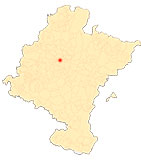The memorial in Pamplona
Monument to Pablo Sarasate
-
Author: Eduardo Carretero.
-
Materials and techniques: Bronze and stone.
-
Measurements: Bronze figure: 220 cm; Stone high relief: 248 x cm.
-
Location: Park of the average Luna.
-
Date of installation: 26 April 1959 (inauguration).
In 1959, Pamplona paid tribute to one of its most illustrious sons, the violinist Pablo Sarasate (Pamplona, 1844-Biarritz, 1908), whose brilliant degree program led him to triumph all over Europe and America, being considered, together with Paganini, as the best concert pianist of his instrument. On this occasion, the City Council promoted a monument in his honour, replacing the one erected in 1918 in the gardens of La Taconera, which was dedicated to the musician and composer Hilarión Eslava.
The author of project was the architect Cándido Ayestarán, while the bronze statue of the Pamplona violinist and the allegorical reliefs on the back of the monument are by the Granada sculptor Eduardo Carretero, who was closely linked at that time to the Navarrese capital through Félix Huarte, who had entrusted him with the sculptural decoration of the parish church of San Francisco Javier designed by Miguel Gortari.
The monument consists of an architectural stone structure comprising three columns and a compact block with an incised high relief on the back with two allegorical figures: one seated, playing the lyre, and the other standing, dressed in chain mail, with a scroll in his right hand and a sword and chains in his left. On the main front is a full-length bronze statue of Pablo Sarasate, elegantly dressed and in a solemn pose. The Pamplona-born violinist is depicted in middle age, coinciding with the fullness of his age degree program, with his characteristic moustache and abundant hair that almost covers his eyebrows; he holds the violin in his left hand, while in his right he holds the bow that rests on the floor. Carretero's ability to capture the character's personality is evident in the way he gives him verisimilitude and almost life in his natural gesture with the violin. However, in the stone reliefs at the back, sample is more emphatic, moving towards an expressionist work of renewed vigour.
-
AZANZA LÓPEZ, J. J., The commemorative monument in Navarre. The identity of a Kingdom. Col. Panorama, nº 31, Pamplona, Government of Navarre, 2003.
-
AZANZA, J. J., MURUZÁBAL, J. M., URRICELQUI, I. and ZUBIAUR, F. J., Guía de escultura urbana en Pamplona, Pamplona, Pamplona City Council, 2009.












